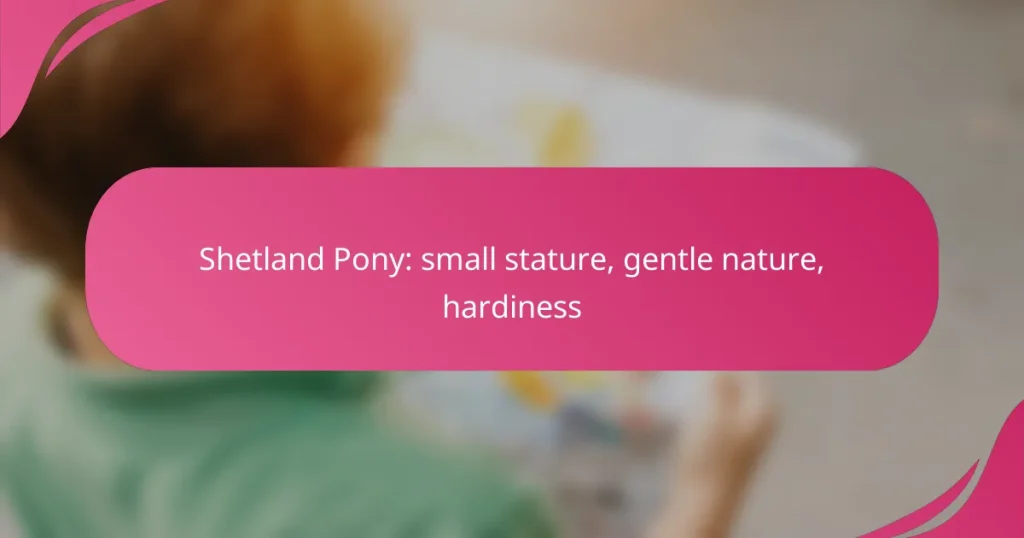The Shetland Pony is a charming breed known for its small stature, gentle disposition, and remarkable hardiness. These ponies make excellent companions, especially for families with children, due to their manageable size and friendly nature. With proper care, including a balanced diet and regular grooming, Shetland Ponies can thrive in various environments while bringing joy to their owners.

What are the benefits of owning a Shetland Pony?
Owning a Shetland Pony offers numerous advantages, including their gentle nature, manageable size, and resilience in various environments. These traits make them ideal companions for families, particularly those with children.
Gentle temperament
Shetland Ponies are known for their calm and gentle demeanor, making them excellent choices for novice riders and children. Their friendly nature encourages positive interactions, fostering a bond between the pony and its owner.
This gentle temperament also means they are less likely to exhibit aggressive behaviors, which can be particularly beneficial in a family setting. Their patience and willingness to learn make training easier and more enjoyable.
Small size for children
With a height typically ranging from 28 to 42 inches, Shetland Ponies are perfectly sized for children. Their small stature allows young riders to feel more confident and secure while learning to ride.
This size also makes them easier to handle for children, as they can manage grooming, feeding, and leading tasks without feeling overwhelmed. Parents often find this aspect reassuring when introducing their kids to equestrian activities.
Hardiness in various climates
Shetland Ponies are remarkably hardy and can thrive in a range of climates, from cold, wet conditions to warmer environments. Their thick coats provide insulation against harsh weather, reducing the need for special housing or care during winter months.
This adaptability makes them suitable for various regions, whether in the UK or other temperate climates. Owners should still monitor their health and adjust care routines based on local weather conditions.
Low maintenance needs
These ponies require relatively low maintenance compared to larger breeds. Regular grooming, basic hoof care, and a balanced diet are typically sufficient to keep them healthy and happy.
Additionally, their smaller size means they consume less feed, which can be more cost-effective for owners. Routine veterinary care is still essential, but overall, Shetland Ponies are less demanding than many other equine options.
Versatile for different activities
Shetland Ponies are incredibly versatile and can participate in various activities, including riding, driving, and even showing. Their friendly nature and trainability make them suitable for both recreational and competitive pursuits.
Families can engage in pony clubs, trail riding, or even local shows, providing a range of experiences for both children and adults. This versatility enhances the enjoyment of owning a Shetland Pony, making them a valuable addition to any household.

How to care for a Shetland Pony in the UK?
Caring for a Shetland Pony in the UK involves providing proper feeding, grooming, and exercise tailored to their unique needs. These small yet hardy ponies thrive with a balanced diet, regular grooming, and adequate physical activity to maintain their health and well-being.
Feeding requirements
Shetland Ponies require a diet that is low in sugar and starch to prevent obesity and related health issues. High-quality hay or pasture should form the basis of their diet, supplemented with a small amount of concentrated feed if necessary, particularly during colder months.
Monitor their body condition regularly to adjust feed amounts accordingly. A typical Shetland Pony may consume around 1.5% to 2% of their body weight in forage daily, depending on their activity level and health status.
Grooming tips
Regular grooming is essential for Shetland Ponies to maintain their coat and skin health. Brush them at least once a week to remove dirt, debris, and loose hair, paying special attention to their thick mane and tail.
Check their hooves frequently, ideally every few weeks, to prevent issues such as thrush or overgrowth. Regular hoof trimming by a qualified farrier is also recommended to keep their feet healthy.
Exercise needs
Shetland Ponies need regular exercise to stay fit and prevent boredom. Aim for at least 30 minutes of active movement each day, which can include riding, lunging, or simply allowing them to roam in a safe area.
Consider their individual temperament and energy levels when planning exercise routines. Some ponies may require more activity, while others may be content with lighter exercise. Always ensure they have access to fresh water and shelter during outdoor activities.

What are common health issues in Shetland Ponies?
Shetland Ponies, known for their small stature and gentle nature, can face several health issues that owners should be aware of. Common problems include laminitis, obesity, and dental issues, each requiring specific attention to ensure the pony’s well-being.
Laminitis
Laminitis is a painful condition affecting the hooves of Shetland Ponies, often triggered by dietary changes or excessive weight. It occurs when the laminae, the tissue connecting the hoof wall to the bone, become inflamed. Owners should monitor their pony’s diet closely, especially during spring when grass growth is rapid.
To prevent laminitis, avoid sudden changes in feed and limit access to rich pastures. Regular hoof care and veterinary check-ups can help catch early signs of laminitis, ensuring timely treatment.
Obesity
Obesity is a significant concern for Shetland Ponies due to their small size and tendency to gain weight easily. Excess weight can lead to various health issues, including laminitis and metabolic disorders. Owners should regularly assess their pony’s body condition score to manage weight effectively.
To prevent obesity, provide a balanced diet with controlled portions and ensure regular exercise. Using slow feeders can help manage their intake and keep them active, reducing the risk of weight-related health problems.
Dental problems
Dental issues are common in Shetland Ponies, particularly as they age. Problems such as uneven wear, sharp edges, and loose teeth can affect their ability to eat properly, leading to weight loss and nutritional deficiencies. Regular dental check-ups are essential for maintaining oral health.
Signs of dental problems include difficulty chewing, dropping feed, or bad breath. Owners should schedule annual dental exams with a veterinarian or equine dentist to address any issues before they become severe.

How to choose the right Shetland Pony?
Choosing the right Shetland Pony involves assessing temperament, considering age, and conducting thorough health checks. Each of these factors plays a crucial role in ensuring that the pony fits well with your lifestyle and needs.
Assessing temperament
The temperament of a Shetland Pony is vital for compatibility with its owner or handler. Generally, these ponies are known for their gentle and friendly nature, making them suitable for children and novice riders. Look for a pony that displays calm behavior and is willing to engage with people.
When assessing temperament, observe how the pony interacts with its environment and other animals. A pony that is curious yet relaxed is often a good choice. Avoid those that show excessive nervousness or aggression, as these traits can lead to challenges in handling.
Age considerations
Age is an important factor when selecting a Shetland Pony, as it influences training needs and energy levels. Younger ponies, typically under five years old, may require more training and socialization, while older ponies may be more experienced and easier to handle.
Consider your own experience level when choosing the age of the pony. If you are a beginner, an older, well-trained pony may be a better fit. Conversely, if you have experience and are looking for a project, a younger pony could provide an opportunity for training and bonding.
Health checks
Conducting health checks is essential to ensure the Shetland Pony is in good condition. Look for signs of good health, such as clear eyes, a shiny coat, and a healthy weight. A veterinary examination can help identify any underlying health issues that may not be immediately visible.
Inquire about the pony’s vaccination history and any previous health concerns. Regular health checks, including dental and hoof care, are crucial for maintaining the pony’s well-being. Ensure that the pony has been properly cared for and has received routine veterinary attention to avoid future issues.

What training methods work best for Shetland Ponies?
Positive reinforcement techniques are the most effective training methods for Shetland Ponies, as they respond well to rewards rather than punishment. These methods foster a trusting relationship and encourage desired behaviors through consistent reinforcement.
Positive reinforcement techniques
Positive reinforcement involves rewarding Shetland Ponies for exhibiting desired behaviors, making it a humane and effective training approach. Common rewards include treats, praise, or additional time spent grazing, which can motivate the pony to repeat the behavior.
When using positive reinforcement, timing is crucial. Rewards should be given immediately after the desired action to help the pony associate the behavior with the reward. For example, if a pony successfully completes a task, offering a treat right away reinforces the connection.
It’s important to vary the rewards to maintain the pony’s interest. You might start with treats but can gradually incorporate verbal praise or petting as the pony becomes more accustomed to the training routine. Avoid over-rewarding to prevent dependency on treats, aiming for a balanced approach that promotes learning without excessive reliance on food.


